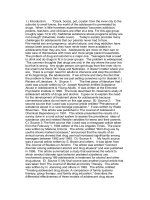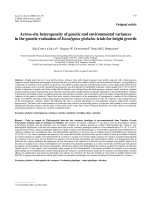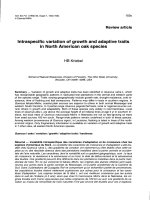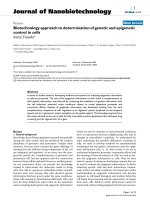Effect of genetic and non-genetic factors on first lactation production and reproduction traits in HF × Gir Cattle
Bạn đang xem bản rút gọn của tài liệu. Xem và tải ngay bản đầy đủ của tài liệu tại đây (203.91 KB, 7 trang )
Int.J.Curr.Microbiol.App.Sci (2019) 8(1): 45-51
International Journal of Current Microbiology and Applied Sciences
ISSN: 2319-7706 Volume 8 Number 01 (2019)
Journal homepage:
Original Research Article
/>
Effect of Genetic and Non-Genetic Factors on First Lactation Production
and Reproduction Traits in HF × Gir Cattle
S.S. Jadhav1*, D.K. Deokar2, Y.G. Fulpagare3, U.Y. Bhoite4,
S.D. Mandkmale5 and C.V. Nimbalker6
1
RCSM College of Agriculture, Kolhapur, India
2
College of Agriculture, Dhule, India
3
Department of Animal Husbandry and Dairy Science, Mahatma Phule Krishi Vidyapeeth,
Rahuri, India
4
Research cum Development Project on Cattle, Mahatma Phule Krishi Vidyapeeth,
Rahuri, India
5
AICRP on Goat, Mahatma Phule Krishi Vidyapeeth, Rahuri, India
6
Department of Statistics, Mahatma Phule Krishi Vidyapeeth, Rahuri, India
*Corresponding author
ABSTRACT
Keywords
HF × Gir cattle,
Genetic parameter,
First lactation traits
Article Info
Accepted:
04 December 2018
Available Online:
10 January 2019
The present investigation was carried out with the objective of performance appraisal of
HF × Gir cattle with respect to production and reproduction traits. The performance
records of 421 HF × Gir half breed cattle sired by 48 bulls were collected for production
and reproduction traits spread over a period of 39 years (1977 to 2015) from ResearchCum Development Project on Cattle, Mahatma Phule Krishi Vidyapeeth, Rahuri District
Ahmednagar (Maharashtra). The overall least squares means for first lactation total milk
yield (FLTMY), first lactation 300 days milk yield, first lactation length (FLL), First dry
period (FDP), First service period (FSP), First calving interval (FCI) and Age at first
calving were 2701.77±46.04, 2511.70 ±37.40, 320.43± 3.04, 88.40±2.58, 130.14±3.19,
409.17±3.25 and 990.69±6.53 days, respectively. Further, the least squares analysis
revealed non significant effect of season of calving and age at first calving groups on all
first lactation reproduction and milk production traits. Whereas, the effect of period of
calving was found to be highly significant on FLTMY, FL300DMY and AFC and nonsignificant on FLL, FDP, FSP and FCI. However, the effect of sire was found to be
significant on FLTMY, FL300DMY and AFC. The heritability of all traits except FCI and
FSP were moderate in magnitude which indicated these traits are more influenced by
additive genetic variability and hence there is more scope for improvement by selection.
The highly significant genetic and phenotypic correlation was found between production
and reproduction traits.
45
Int.J.Curr.Microbiol.App.Sci (2019) 8(1): 45-51
Ahmednagar (Maharashtra State). Only the
sires having records at least 3 daughters were
included in the present study. The first
lactation length less than 150 days was
considered as abnormal and was not included
in the analysis. The total duration of the
present study was divided into 6 periods. Each
year was divided into three seasons namely
Rainy (S1), Winter (S2) and summer (S3)
various first lactation traits were considered
for the study which were age at first calving
(AFC). First lactation total milk yield
(FLTMY), first lactation 300 days milk yield.
(FL300DMY), first lactation length (FLL),
First service period (FSP) First Dry period
(FDP) and First calving interval (FCI).For
accurate estimation of genetic variation
present in traits as well as to account for the
effect of non-genetic factors, both the genetic
and non genetic factors were considered.
Introduction
Livestock sector is an important subsector of
the agriculture of Indian economy. It forms an
important livelihood activity for most of the
farmers, supporting agriculture in the form of
critical inputs, contribute into the health and
nutrition of the household, supplementing
income, offering employment opportunities,
and finally being a dependable “bank on
hooves” in times of need. It acts as a
supplementary and complementary enterprise.
They further also play a significant role in
generating gainful employment in the rural
sector, particularly among the landless, small
and marginal farmers and women, besides
providing cheap and nutritious food to
millions of people. Milk yield is an important
economic trait in livestock species. It
represents a major source of income in most
dairy enterprises.
Statistical analysis
Economic traits are generally controlled by
genetic factors but environmental influences
like year, season and age at first calving have
significant effects on milk yield. These
environmental factors may suppress the
animal‟s true genetic ability and create a bias
in the selection of animals. Heritability is
required to calculate genetic evaluations to
predict response to selection and to help
producers decide if it is more efficient to
improve traits through management or through
selection. Therefore, present study was aimed
to evaluate first lactation traits and estimates
their genetic parameters in HF × Gir half
breed cattle.
The mixed model analysis using least squares
maximum likelihood (LSML) program
(Harvey, 1990) was used for determining the
influence of genetic and non-genetic factors
on first lactation production and reproduction
traits and estimation of genetic parameters,
simultaneously. The model incorporated
seasons, period‟s age at first calving as fixed
effects and sires as random effects. The
statistical significance of various fixed effects
in the least squares model was determined by
„F‟ test for significant effects the difference
between pairs of levels of effects were tested
by Duncan‟s multiple range test as modified
by Kramer (1957). The heritability, genetic
and phenotypic correlations were obtained
from the above LSML software.
Materials and Methods
The data for the present investigation were
collected for a period of 40 years (1974-2015)
form History sheet of 421 HF × Gir half breed
cows born from 48 sires maintained at
Research cum Development Project (RCDP)
on
cattle,
MPKV
Rahuri,
District-
Results and Discussion
The overall least- squares means and
coefficient of variation of productive and
reproductive traits are presented in Table 1.
46
Int.J.Curr.Microbiol.App.Sci (2019) 8(1): 45-51
The overall least-squares mean of FLTMY,
FL300days, FLL, FSP, FDP, FCI and AFC
were 2701.77± 46.04, 2511.70 ±37.40,
320.43± 3.04, 88.40±2.58, 130.14±3.19,
409.17±3.25 and 990.69±6.53 respectively.
results were reported by Akhtar et al., (2003)
in 5/8 HF × 3/8 SW cattle, Singh et al., (2014)
in frieswal and Divya (2012) in Karan fries
cattle.
The non-significant effect of sire was found
on FSP, FLL, FDP and FCI. The findings
were in consonance with Akhtar et al., (2013)
and Ambhore et al., (2017) in 5/8 HF × 3/8
SW and Phule Triveni cattle, respectively.
Effect of season of calving/ birth on first
lactation production and reproduction
traits
The influence of season of calving was found
to be non-significant on all production and
reproduction traits of first lactation in HF ×
Gir half breed cattle. The non-significant
effect of season of calving on first lactation
traits was also reported by many workers
(Rashid, 2010; Nehra, 2011 and Divya, 2012)
in KF cattle. Contradictory to the present
study significant effect of season of calving of
FL300DMY and FLTMY has been
documented by Mukherjee (2005) and Rathee
(2015) in frieswal cattle.
Effect of age at first calving on first
lactation production and reproduction
traits
The non-significant effect of AFC groups was
found on all first lactation production and
reproduction traits. This finding was similar to
the results reported by Singh (1995), Divya
(2012) and Singh (2013) in Karan fries cattle.
Whereas significant effect of age groups on
FL300 DMY and FLL were reported by
Ambhore (2017) in Phule Triveni cattle.
Effect of period of calving / birth on first
lactation production and reproduction
traits
Heritability estimates of production and
reproduction traits
Period of calving have a highly significant
effect on age at first calving, (AFC), FLTMY
and FL 300 days milk yield. Whereas nonsignificant effect on FLL, FSP, FDP and FCI.
The lowest AFC were found in period first
(Table 1). Higher estimates for FLTMY and
FL300 days were found in period first. Similar
estimates were reported by Mukherjee (2005),
Shelke (2012) and Ambhore (2017) in various
crossbreeds. Reproduction traits were not
significantly affected by period of calving.
These non-significant finding were in
accordance with Saha (2001) and Singh and
Gurani (2004) in KF cattle.
The heritability of AFC, FL300DMY,
FLTMY and FDP & FLL were moderate.
Which indicates that these traits were more
influenced by additive genetic variability and
could be improved by selection and improved
management. Whereas, the heritability (h2) of
FSP, and FCI were very low and associated
with high standard error indicating that
performance of this trait could be enhanced by
improving management and environments
factors. The higher heritability of AFC and FL
300 days milk yield in HF × Gir half breed
cattle. Indicates that selections based on these
two traits are more desirable than other traits.
The present results were in agreement with the
finding reported by Mukherjee (2005) in
Frieswal cattle, Nehra (2011) and Dash (2014)
in KF cattle and Ambhore (2017) in Phule
Triveni cattle.
Effect of sire on first lactation production
and reproduction traits
The sire had significant (P˂ 0.05) effect on
AFC, FLTMY and FL300DMY. Similar
47
Int.J.Curr.Microbiol.App.Sci (2019) 8(1): 45-51
Table.1 Least squares means of first lactation reproduction and production traits of HF × Gir half bred
Source of variation
N
FL300DMY (kg)
421
FSP
(days)
Mean + S.E.
130.14 ± 3.19
Mean + S.E.
2511.70 ± 37.40
FLTMY
(kg)
Mean + S.E.
2701.77 ± 46.04
FLL
(days)
Mean + S.E.
320.43 ± 3.04
FDP
(days)
Mean + S.E.
88.40 ± 2.58
FCI
(days)
Mean + S.E.
409.17 ± 3.25
Overall mean (µ)
Periods of calving
P1 (1974-1980)
P2 (1981-1987)
P3 (1988-1994)
P4 (1995-2000)
P5 (2002-2008)
P6 (2009-2015)
Season of birth
S1: Rainy
S2: Winter
S3: Summer
Age group
A1: < 905 days
A2: 950-1050 days
A3 : 1051 days and
above
156
61
47
77
50
30
127.51 ± 6.22
124.88 ± 7.07
133.5 ± 8.00
135.77 ± 6.5
126.69 ± 8.02
132.51 ± 10.00
3238.74 ± 72a
2752.06 ± 82b
2350.84 ± 94c
2242.12 ± 76c
2188.89 ± 93c
2297.58 ± 117c
3388.09 ± 87a
2953.71 ± 101b
2539.17 ± 116c
2510.84 ± 93c
2334.08 ± 115c
2484.74 ± 145c
319.75 ± 86.72
322.98 ± 7.69
322.98 ± 769
334.46 ± 6.19
320.59 ± 7.63
305.28 ± 9.59
86.01 ± 5.02
80.19 ± 5.70
88.49 ± 6.52
80.51 ± 5.25
86.45 ± 6.47
108.76 ± 8.13
405.5 ± 6.33
401.37 ± 7.19
413.94 ± 8.22
415.93 ± 6.62
407.60 ± 8.16
410.63 ± 10.25
110
146
165
126.77 ± 5.55
127.47 ± 4.79
136.19 ± 4.57
2504.98 ± 64
2507.35 ± 56
2522.79 ± 53
2680.22 ± 79
2672.76 ± 68
2752.34 ± 65
322.92 ± 5.33
314.03 ± 4.56
324.35 ± 4.35
80.83 ± 4.47
93.43 ± 3.86
90.94 ± 3.69
404.8 ± 5.64
407.3 ± 4.87
415.40 ± 4.65
232
75
114
127.78 ± 5.08
136.34 ± 6.47
126.31 ± 5.66
2462.58 ± 59
2484.84 ± 75
2587.69 ±66
2671.02 ± 73
2682.78 ± 93
2751.53 ± 81
322.46 ± 4.83
328.70 ± 6.16
310.14 ± 5.39
83.89 ± 4.10
86.08 ± 5.22
95.24 ± 4.57
406.87 ± 5.57
414.15 ± 6.59
406.49 ± 5.76
Means under each class in the same column with different super scripts differ significantly
Table.2 Estimates of heritability, phenotypic and genetic correlations among first lactation reproduction and production traits
Traits
AFC
FLL
FSP
FDP
FCI
FL300DMY
FLTMY
AFC
0.20 ± 0.12
0.06 ± 0.02
0.72 ± 0.15*
0.72 ± 0.18*
0.53 ± 0.35
-0.03 ± 0.48
-0.27 ± 0.64
FLL
-0.10 ± 0.42
0.11 ± 0.10
0.20 ± 0.10
0.10 ± 0.06
0.53 ± 0.11**
0.48 ± 0.71**
0.69 ± 0.27
FSP
0.05 ± 0.08
0.65 ± 0.87
0.02 ± 0.11
0.47 ± 0.34
0.96 ± 0.56
0.21 ± 0.70
0.42 ± 0.55
FDP
-0.03 ± 0.09
-0.29 ± 0.56
0.70 ± 0.12
0.12 ± 0.12
0.47 ± 0.45
-0.26 ± 0.30
-0.24 ± 0.06
FCI
0.04 ± 0.15
0.65 ± 0.46*
0.93 ± 0.16*
0.50 ± 0.23
0.02 ± 0.11
0.22 ± 0.42
0.42 ± 0.65
FL300DMY
FLTMY
0.07 ± 0.05
0.08 ± 0.15*
0.48 ± 0.09** 0.60 ± 0.08**
0.34 ± 0.03**
0.34 ± 0.03
-0.06 ± 0.61** -0.24 ± 0.02**
0.80 ± 0.09
0.34 ± 0.02**
0.19 ± 0.14
0.87 ± 0.10**
0.18 ± 0.10
0.92 ± 0.05**
Estimates above the diagonal are the genetic correlations and below diagonal are phenotypic correlations. The diagonal values are the
estimates
of
heritability;
*P
<
0.05
and
**
P
48
<
0.01
Int.J.Curr.Microbiol.App.Sci (2019) 8(1): 45-51
Table.3 Analysis of variance of various first lactation reproduction and milk production traits as
affected by genetic and non genetic factors
Source
of
Mean sum of squares
variation
AFC
FSP
FL300DMY
FLTMY
Period of birth 1112960.18** 1132.82 9931810.45** 9052380.68**
for AFC/
Period of
calving
Season of birth
11308.48 4084.65 13726.15
293640.63
for AFC/
Season of
calving
Age at first
2477.48 38445.12
163159.94
calving group
Sire
19522.01* 2302.75 550409.00* 834083.86*
Error
27008.67 2963.63 517003.44
711149.98
FLL
FDP
FCI
4002.76 3999.93 1754.27
4540.21 5308.51 4396.26
7603.45 3132.56 1573.53
3343.02 2029.71 2470.59
2732.24 1929.20 3068.27
*P < 0.05 and ** P < 0.01
Table.4 Least squares means of age at first calving as affected by various factors in HF × Gir
halfbred
Source of variation
N
Mean + S.E.
Overall mean (µ)
Periods of birth
P1 (1974-1980)
P2 (1981-1987)
P3 (1988-1994)
P4 (1995-2000)
P5 (2002-2008)
P6 (2009-2015)
Season of birth
S1: Rainy
S2: Winter
S3: Summer
421
990.69 ± 6.53
157
61
54
70
50
29
804.11 ± 9.52c
968.18 ± 15.12b
974.73 ± 16.20b
1080.73 ± 14.11a
1080.27 ± 16.77a
1036.13 ± 22.01a
137
157
127
987.05 ± 10.82
983.84 ± 10.05
1001.18 ± 10.73
Means under each class in the same column with different super scripts differ significantly
between FLTMY and FL 300 DMY was
0.87±0.10 and 0.92±0.05 between FLTMY
and FLL was 0.60 ± 0.08 and 0.69 ±0.27
between FLTMY and FDP was 0.24±0.02 and
0.24±0.06 between FLTMY and AFC was
0.08±0.15 and 0.27±0.64 between FLTMY
and FCI was 0.34±0.03 and 0.42 ±0.65 and
Genetic and Phenotypic correlations of
milk production and reproduction traits
The genetic (rg) and the Phenotypic (rp)
correlation of first lactation production and
reproduction traits are presented in Table 2.
The genetic and phenotypic correlations
49
Int.J.Curr.Microbiol.App.Sci (2019) 8(1): 45-51
between FLTMY, FSP was 01.34±0.02 and
0.42±0.55. The positively phenotypic
correlation between FLTMY with FLL, FSP
and FCI indicated that increase in first
lactation FLTMY also tend to increase service
period, Lactation length and calving interval
(Table 3). However, genetic correlation of
FLTMY and FL 300 DMY with FDP was
negative and desirable indicating that cows
producing more milk have shorter dry period.
Similar to the present findings, Mukherjee
(2005) also reported higher genetic
correlation of FLTMY with FL 300 DMY and
FLL in Frieswal cattle and the phenotypic
correlation of milk Production with AFC was
0.13±0.12 and with FLL it was 0.09 ± 0.40 in
Karan Fries, cattle Nehra (2011).
indicated these traits are more influenced by
additive genetic variability and hence there is
more scope for improvement by selection.
The low heritability estimate of FCI and FSP
trait indicates that it is influenced more by
managemental and environmental factors than
by genetic factors.
Acknowledgement
The authors wish to express their gratitude to
the Vice- Chancellor, MPKV, Rahuri for
providing necessary facilities for conducting
the investigation.
References
Akhtar, J., Singh, M., Kumar, D and Sharma,
K. 2003.Factors affecting economic
traits in crossbred cattle. Indian J. Anim.
Sci. 73(4): 464-465.
Ambhore, G.S., Singh, A., Deokar, D.K.,
Gupta,
A.K.,
Singh,
M.
and
VedPrakash. 2017. First lactation
production
and
reproduction
performance of Phule Triveni cattle in
hot arid region of Maharashtra. Indian
J. Anim. Sci. 87(1): 105-108
Dash, S.K., 2014 Genetic evaluation of Karan
Fries cattle for fertility and production
traits. Ph. D. Thesis, National Dairy
Research Institute, Karnal, India.
Divya, P. 2012. Single versus multi-trait
models for genetic evaluation of fertility
traits in Karan Fries cattle. M.V.Sc.
Thesis, National Dairy Research
Institute, Karnal, India.
Harvey, W.R. 1990. Guide for LSMLMW,
PC-1 Version, mixed model least
squares and maximum likelihood
computer programme, January 1990.
Mimeograph Ohio State Univ., USA.
Kramer, C.V. 1957. Extension of multiple
range test to group correlated adjusted
mean. Biometric., 13: 13-20.
Mukherjee, S. 2005. Genetic evaluation of
Impacts
The average least squares mean of first
lactation were FLTMY 2701.77 ± 46.04 kg,
FL300DMY 2511.70 ± 37.40 kg, FLL 320.43
± 3.04 days, FDP 88.40 ± 2.58 days, AFC
990.69 ± 6.53 days, FCI 409.17 ± 3.25 days
and FSP 130.14 ± 3.16 days (Table 4).
Among the different genetic and non-genetic
factors studied, period of calving had
significant effect on FLTMY, FL300DMY
and AFC and non significant effect on FLL,
FDP, FCI and FSP. Season of calving and age
at first calving group had non significant
effect on all first lactation production and
reproduction traits. The sire had significant
effect on FLTMY, FL300DMY and AFC and
non-significant effect on FLL, FDP, FCI and
FSP.
The heritability estimates of FL300DMY,
FLTMY, FLL, FDP, AFC, FCI and FSP were
0.19 ± 0.14, 0.18 ± 0.10, 0.11 ± 0.10, 0.12 ±
0.12, 0.20 ± 0.12, 0.02 ± 0.11 and 0.02 ± 0.11,
respectively. The heritability of all traits
except FCI and FSP from mixed model using
LSML was moderate in magnitude which
50
Int.J.Curr.Microbiol.App.Sci (2019) 8(1): 45-51
Frieswal cattle. Ph.D. Thesis, National
Dairy Research Institute (Deemed
University) Karnal, (India).
Nehra, M. 2011.Genetic analysis of
performance trends in Karan Fries
cattle. M.V.Sc. Thesis. NDRI (Deemed
University) Karnal, India.
RashiaBanu, N. 2010.Genetic evaluation of
the lactation curve in Karan Fries cattle.
Ph.D.
Thesis.
NDRI
(Deemed
University), Karnal, India.
Saha. 2001. Generation wise genetic
evaluation of Karan Swiss and Karan
Fries cattle. M.Sc. Thesis. NDRI
Deemed University, Karnal, India.
Shelke, M.G. 2012. Generation wise
persistency of milk production in Phule
Triveni Synthetic cows. M. Sc (Agri.)
Thesis submitted to MPKV, Rahuri.
Singh, R.K. 2013.Genetic evaluation of Karan
Fries sires using multiple trait models.
Ph.D thesis submitted to NDRI, Karnal
(Haryana).
Singh, M.K. 1995. Factors affecting trend in
performance of Karan Swiss and Karan
Fries cattle. Ph.D Thesis, NDRI
(Deemed University) Karnal, India.
Singh, M.K. and Gurnani, M. 2004.
Performance evaluation of Karan Fries
and Karan Swiss cattle under closed
breeding system. Asian- Australasian J.
Anim. Sci., 17(1): 1 - 6.
How to cite this article:
Jadhav, S.S., D.K. Deokar, Y.G. Fulpagare, U.Y. Bhoite, S.D. Mandkmale and Nimbalker,
C.V. 2019. Effect of Genetic and Non-Genetic Factors on First Lactation Production and
Reproduction Traits in HF × Gir Cattle. Int.J.Curr.Microbiol.App.Sci. 8(01): 45-51.
doi: />
51









